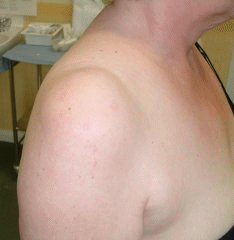Rotator Cuff Repair
'Even at my age'
Arthroscopic Rotator Cuff Repair
- Mrs C Beck
I stepped on my dressing gown belt at the top of the stairs, flung my right arm out and wrenched my shoulder saving myself from the long fall. It was agony.
A couple of weeks later my bruises had gone but when I used my shoulder it hurt and my arm refused to move more than a few degrees above horizontal - my doctor diagnosed a frozen shoulder.
It became clear that any movement that pushed my upper arm into the socket caused pain a good night's sleep was a distant memory and if I drove for more than 15 minutes the right arm felt as if it was receiving a non stop injection.
I had to develop some "coping strategies".
1. I slept with a pillow behind my back to stop me rolling over onto my right side.
2. Raised my computer chair and moved the mouse to the left hand side [it only took a few days to get used to this and even now is more convenient because my right hand is free to take pencil notes from the screen.]
3. Put one or two cushions on chairs so that my elbow was higher than any table.
4. Stood on a small stool to hang out washing.
5. I planned my driving for less than 15 mins and kept out of rush hours, just possible with my job.
6. Pushed open department store doors with my body not hand.
7. Always put my bad arm into clothes first.
Physio began several weeks later and it hurt - a lot. "Work through the pain" was the physio's mantra and I did try- very hard.
I had an extremely painful steroid injection, which was supposed to help free up the shoulder. It did nothing.
[see Injection Review]
Every day for eleven weeks I did all the exercises that had been set out at the previous session and it hurt, the more I did the more it hurt, so half-way through the twelfth week I stopped exercising and the pain receded a bit.
Back to my doctor who was disappointed that the physio had not worked and did the classic routine of "at your age [a healthy 60 ] you must expect some wear and tear". I pointed out that both my arms were the same age and I had had no problem at all until the fall on the stairs.
Several months later I had moved up the waiting list and saw an Orthopaedic Surgeon, who recommended an MRI and another steroid injection. The pain made me faint and not surprisingly the injection did not help free the shoulder.
The waiting list for an MRI was 12 to 18 months and was now essential to see exactly what had happened to my shoulder. Maybe someone who watches ER or similar hospital programme would have known what to expect but I did not. I found it a bit weird inside the MRI as I had not expected to be shoved into a small metal tube and I found the music far too loud when my ear plug fell out as I was pushed in but after a painless and boring 15 minutes and lots of mechanical clonking it was over and I was outside the tube again. I would recommend you take your own tape of favourite music and the operator will play it to you during the MRI.
Result - I had torn a tendon.
[Portable Office Ultrasound would have provided instant diagnosis of the rotator cuff tear]
After what seemed like years the date for the rotator cuff operation was approaching when my consultant offered to transfer me to Mr Funk, a specialist in key hole surgery. This offers a big bonus of small shoulder scars and day surgery. I went in at eight o'clock on the day of the operation and was asked to choose between a minor operation [in a sling for a week ] which scraped the inside socket of my shoulder smooth to stop the pain because the tendon has nothing to rub against, or a major operation [in a sling for six weeks ] which mended the tendon and scraped the inside socket of the shoulder smooth. I asked for the complete job.
I woke up with my shoulder in a sling strapped to my body and slight pain and was given some strong painkillers to take home.
I slept on my left with a pillow behind my back and rarely needed any painkillers after a few days. Physio was a great help and for the first few weeks I could see the shoulder movement increasing with every exercise, there was very little discomfort and then I reached a point where I could move my arm no higher. Luckily for me my regular physio was away and the senior physio found out I had not been put on my left side with my right arm suspended freely just above my body and allowed to swing my arm forward and backward. That exercise had amazing results and my arm decided to work properly. Of course I had to do all the movement and scapula position exercises for many months after the operation but at least it was all worthwhile - "even at my age".
Mrs Beck 3 months after surgery:
Photograph of the healed
surgical scars (arrows):
Video of Shoulder Movement
(Operated side is on the Right):


